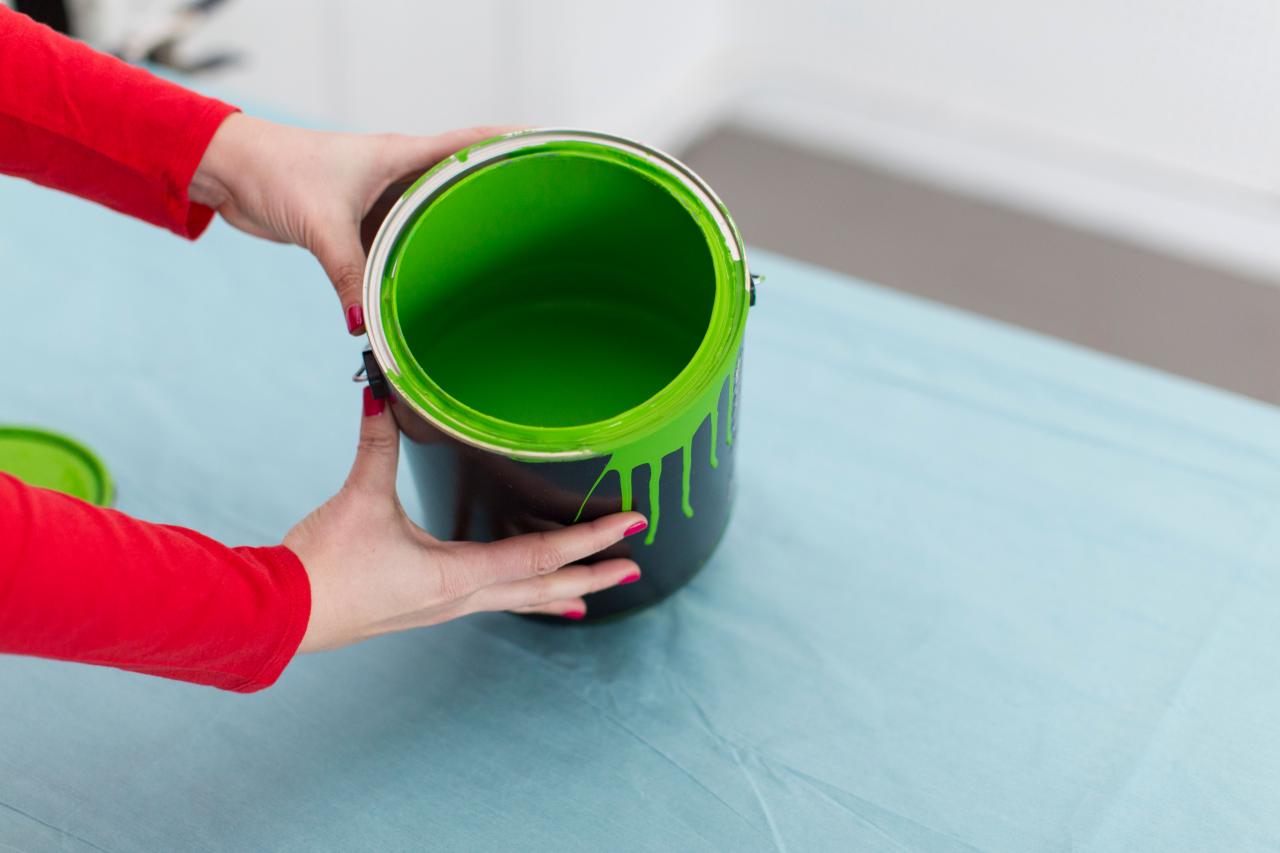

Articles
How To Store Leftover Paint
Modified: August 22, 2024
Learn how to properly store leftover paint with our helpful articles. Keep your paint fresh and ready to use for your next project.
(Many of the links in this article redirect to a specific reviewed product. Your purchase of these products through affiliate links helps to generate commission for Storables.com, at no extra cost. Learn more)
Introduction
When it comes to home improvement projects, it’s not uncommon to have leftover paint. Whether you’re touching up a wall or completely repainting a room, you may find yourself with partially filled paint cans that need to be stored for future use. Properly storing leftover paint is essential to ensure its longevity and usability for future projects.
Leftover paint can be a valuable asset, saving you time and money when it comes to future touch-ups or small painting jobs. However, if not stored correctly, paint can become unusable, wasted, or even hazardous.
In this article, we will discuss the best practices for storing leftover paint, including how to properly seal paint cans, the ideal conditions for storage, the importance of labeling your paint, choosing the right storage location, tips for storing different types of paint, and how to deal with dried or expired paint.
By following these guidelines, you can ensure that your leftover paint remains in good condition and ready for your next project, saving you time, money, and the hassle of purchasing new paint unnecessarily.
Key Takeaways:
- Properly sealing and storing leftover paint in the right conditions, labeled accurately, and choosing the right storage location can extend its lifespan, save money, and reduce waste for future home improvement projects.
- Reviving dried or expired paint by checking expiration dates, stirring, adding water or paint thinner, and proper disposal can help maximize the usability of leftover paint while minimizing environmental impact.
Read more: How To Store Leftover Diamond Painting Beads
Properly Sealing Paint Cans
One of the most important steps in storing leftover paint is ensuring that the cans are sealed properly. This is crucial to prevent air exposure, which can lead to paint drying out or becoming unusable over time. Here are some tips for properly sealing paint cans:
- Remove excess paint: Before sealing the can, use a paintbrush or putty knife to remove any excess paint from the rim and the inside of the lid. This prevents the paint from drying and creating a seal that is difficult to open in the future.
- Clean the rim: Make sure the rim of the can is clean and free from any paint residue. This will ensure a tight seal when the lid is secured.
- Place a plastic wrap: To create an airtight seal, you can also place a plastic wrap over the opening of the can before placing the lid. This extra layer helps to prevent air from entering and keeps the paint fresh.
- Tap the lid: Once the lid is in place, tap it gently with a rubber mallet or a hammer to ensure a secure and tight seal. This helps to prevent any leakage or air exposure.
- Store cans upside down: Another option is to store the cans upside down. This creates a seal between the paint and the lid, preventing air from entering. However, not all cans are suitable for upside-down storage, so check the manufacturer’s recommendations first.
Properly sealing your paint cans is essential to maintain the quality and longevity of the paint. By following these simple steps, you can ensure that your leftover paint remains fresh and ready to use for future projects.
Storing Paint Cans in the Right Conditions
In addition to properly sealing paint cans, it’s important to store them in the right conditions to maximize their shelf life. Here are some tips for storing paint cans in the optimal conditions:
- Temperature: Paint should be stored in a cool, dry place. Extreme temperatures can cause the paint to deteriorate, affecting its quality and usability. Avoid storing paint cans in areas that are subject to high temperatures or extreme fluctuations, such as attics or garages.
- Avoid direct sunlight: Exposure to sunlight can lead to color fading and degradation of paint. Store paint cans in a dark area or use opaque storage containers to protect them from UV rays.
- Humidity: Excessive humidity can cause the paint to thicken or mold to develop. Choose a storage location with low moisture levels, away from areas like basements or bathrooms that tend to be more humid. If needed, invest in a dehumidifier to maintain optimal humidity levels.
- Stable environment: Paint cans should be stored in a stable environment, free from vibration or excessive movement. It’s best to avoid storing paint cans near appliances or areas where there may be frequent disturbances.
- Keep out of reach of children and pets: Ensure that the storage location is inaccessible to children and pets. Paint cans contain potentially harmful chemicals and should be stored in a secured place to prevent accidents.
By storing your paint cans in the right conditions, you can prolong their shelf life and maintain the quality of the paint. Be mindful of the storage environment and take the necessary precautions to ensure that your leftover paint remains in good condition until you are ready to use it again.
Labeling Your Leftover Paint
Properly labeling your leftover paint is an important step in the storage process. Clear and accurate labeling allows you to easily identify and retrieve the desired paint when needed. Follow these tips for labeling your leftover paint:
- Paint color: Clearly indicate the color of the paint on the label. Use the specific color name or code if available. This will save you time and effort when searching for a particular shade in the future.
- Paint type: Specify the type of paint (e.g., latex, acrylic, oil-based, etc.) on the label. Different paint types have different storage requirements, so this information will help you identify which paint to use for specific projects.
- Date: Write down the date you stored the paint. This will help you keep track of how long the paint has been stored and determine its lifespan. It’s generally recommended to use latex-based paint within one year and oil-based paint within two years.
- Room or project: If the paint is specific to a particular room or project, note that on the label. This can be helpful if you need to touch up a specific area or if you have multiple paint cans for different projects.
- Additional notes: Consider adding any additional notes on the label, such as the brand of the paint, the sheen (e.g., matte, satin, semi-gloss), or any special instructions or mixing ratios. These details will provide a comprehensive overview of the paint for future reference.
Ensure that the label is legible and securely attached to the paint can. Avoid placing labels in areas that may rub off or get smudged easily. By properly labeling your leftover paint, you can save time, prevent confusion, and make the process of finding and using paint for future projects much more convenient.
Store leftover paint in a cool, dry place away from direct sunlight and extreme temperatures. Seal the lid tightly and store the paint can upside down to create a better seal and prevent air from entering.
Choosing the Right Storage Location
Selecting the proper storage location for your leftover paint is essential to maintain its quality and longevity. Here are some factors to consider when choosing the right storage location:
- Indoor storage: Ideally, store your paint cans indoors rather than in outdoor sheds or garages. Indoor spaces provide better temperature and humidity control, ensuring that the paint remains in good condition.
- Temperature control: Look for a storage area that maintains a consistent temperature. Extreme heat or cold can damage the paint. Basements or closets located inside your home are often suitable options.
- Stability: Choose a location that is stable and does not experience frequent movements or vibrations. Avoid storing paint cans near appliances or items that generate heat, as this can affect the paint’s quality.
- Accessibility: Ensure that the storage location is easily accessible so you can retrieve the paint when needed. Avoid stacking paint cans too high or in hard-to-reach places that might make it difficult to find and retrieve a specific can.
- Away from sunlight: Protect your paint from direct sunlight by storing cans in a dark area or using opaque containers. Exposure to sunlight can cause the paint to deteriorate, affecting its color and consistency.
- Secure storage: If you have children or pets, it’s crucial to store paint cans in a secure location to prevent accidental access. Consider using lockable cabinets or placing the paint out of reach in a locked room.
By considering these factors, you can choose the right storage location for your leftover paint. Maintaining a suitable environment will help preserve the paint’s quality, ensuring that it remains usable for future projects.
Read more: How To Store Leftover Sushi
Tips for Storing Different Types of Paint
Different types of paint have specific storage requirements to maintain their quality and usability. Here are some tips for storing different types of paint:
- Latex-based paint: Latex-based or water-based paint is the most common type used for interior walls and ceilings. To store latex-based paint, make sure the can is sealed tightly to prevent air exposure. Store it in a cool, dry place with stable temperature and humidity levels. Avoid freezing or exposing the paint to extreme heat, as it can cause the paint to separate or become clumpy.
- Oil-based paint: Oil-based paint is known for its durability and smooth finish. When storing oil-based paint, ensure that the lid is tightly sealed to prevent air from entering. Oil-based paint should be stored in a cool, dry place, away from direct sunlight or extreme temperatures. To prevent the paint from drying out, you can place a layer of plastic wrap between the paint and the lid before sealing the can.
- Aerosol paint: Aerosol paint requires special care during storage. Keep aerosol cans in a cool place and avoid exposure to high temperatures or direct sunlight. Store them upright to prevent leakage or pressure buildup. Ensure that the nozzle is clean and free from paint residue to ensure proper functionality.
- Specialty paints: Specialty paints, such as enamel or textured paints, may have specific storage instructions provided by the manufacturer. Follow their guidelines regarding temperature, humidity, and other storage requirements.
- Primer and varnish: Primer and varnish are typically stored in similar ways as the type of paint they correspond to. Ensure proper sealing and store them in a cool, dry location with stable temperature and humidity levels.
- Unopened paint: If you have unopened cans of paint, store them in their original packaging in a cool, dry place. Check the manufacturer’s instructions for any specific storage recommendations.
Remember to always refer to the manufacturer’s instructions and recommendations for your specific type of paint. Following these tips will help preserve the quality and usability of the different types of paint you have stored, ensuring they remain in good condition for future use.
Dealing with Dried or Expired Paint
Over time, paint can dry out or expire, making it unusable for future projects. Here are some tips for dealing with dried or expired paint:
- Check the expiration date: Before attempting to use the paint, check the expiration date on the can. Most paints have a recommended shelf life of one to two years. If the paint has expired, it is best to dispose of it properly.
- Inspect the paint: If the paint has not passed its expiration date but appears dried out or has developed a thick consistency, you can try reviving it. Start by opening the can and examining the paint. If there are clumps or a hardened layer on the surface, it may be difficult to salvage.
- Stir and mix: If the paint has separated and appears chunky or lumpy, try stirring it thoroughly with a paint stir stick or a mixer attachment on a drill. This can help blend the pigments and additives back together.
- Add water or paint thinner: For water-based paints, you can try adding a small amount of water to thin out the paint. Start with a few drops and gradually increase if needed, mixing well after each addition. Similarly, for oil-based paints, you can use the appropriate paint thinner to help restore the desired consistency.
- Strain the paint: If the paint still appears lumpy or contains dried particles, strain it through a fine mesh strainer or a piece of cheesecloth before using. This will remove any clumps or debris, ensuring smoother application.
- Perform a test patch: After refreshing the paint as much as possible, perform a test patch on a small area to evaluate its quality and consistency. This will help you determine if the paint is still usable for your intended project.
- Proper disposal: If the paint is completely dried, expired, or cannot be salvaged, it should be disposed of properly. Check local regulations for guidance on how to dispose of paint in your area. Many communities have specific guidelines for disposal to avoid environmental harm.
While it is possible to revive dried or expired paint in some cases, it’s important to assess the condition and quality of the paint before using it. If the paint cannot be restored to a satisfactory state, it is best to discard it and purchase fresh paint for your projects.
Conclusion
Properly storing leftover paint is essential to maximize its lifespan and usability for future projects. By following the guidelines outlined in this article, you can ensure that your paint remains in good condition and ready to use whenever needed. Remember the key steps and recommendations for storing leftover paint:
- Properly seal paint cans by removing excess paint, cleaning the rim, and tapping the lid to create a tight seal.
- Store paint cans in the right conditions, including a cool, dry place away from direct sunlight and with stable temperature and humidity levels.
- Label your leftover paint with information such as color, type, date, and additional notes to easily identify and retrieve the desired paint.
- Choose the right storage location, preferably indoors, with temperature control and stability.
- Follow specific tips for storing different types of paint, considering their specific requirements.
- Deal with dried or expired paint by checking the expiration date, stirring and mixing, adding water or paint thinner, straining, and performing a test patch before use.
By taking these steps, you can extend the lifespan of your leftover paint, save money by reusing paint for touch-ups or small projects, and reduce waste. Remember to follow any additional instructions provided by the paint manufacturer for the best results.
Proper storage and preservation of paint not only contribute to the longevity of the product but also ensure that you have paint readily available for future touch-ups and home improvement projects. When stored correctly, the paint will be in good condition and ready for use whenever a painting project arises, saving you time, money, and unnecessary trips to the paint store.
So, the next time you have leftover paint, remember to properly seal the cans, store them in the optimal conditions, label them accurately, choose the right storage location, and follow the specific tips for different types of paint. By doing so, you can make the most of your leftover paint and ensure its usability for many projects to come.
Frequently Asked Questions about How To Store Leftover Paint
Was this page helpful?
At Storables.com, we guarantee accurate and reliable information. Our content, validated by Expert Board Contributors, is crafted following stringent Editorial Policies. We're committed to providing you with well-researched, expert-backed insights for all your informational needs.















0 thoughts on “How To Store Leftover Paint”